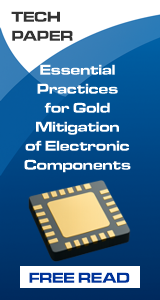|

|
Engineered Cleaning Agent Study Rinsing under Low Profile Components
Materials Tech |
|
Authored By:Vladimir Sitko, Jiri Los PBT Works Rožnov pod Radhoštěm, Czech Republic Mike Bixenman KYZEN Corporation TN, USA Mark McMeen Magnalytix, LLC TN, USA SummaryBest practice for cleaning printed circuit board assemblies (PCBA) uses an aqueous-based process. The engineered aqueous cleaning material uses low vapor pressure oxygenated compounds that combine ethers, glycols, and modified alcohols blended into an aqueous medium. The cleaning fluid is typically diluted in water and delivered to the electronic assembly being cleaned using spray-in-air cleaning tools. Aqueous cleaning processes are dynamic. Flux and process residues removed from the PCBA’s are non-volatile. As the non-volatile residues build up into the wash chemistry, rinsing can be compromised. Additionally, some engineered cleaning agents are harder to rinse than other designs. The purpose of this research is to study rinsing effects as a function of loading and cleaning agent design. A new type of sensor for non-ionic organic compounds integrated within the machine will be used to monitor both cleaning agent saturation and flux residues within the rinse streams. A custom-designed SIR test board will be used to monitor rinsing effects. Absorbance, conductivity, contact angle measurements, and SIR response will be used to monitor rinse water quality. ConclusionsIt is well known that properly cleaned circuit assemblies exhibit improved climatic reliability. Cleaning is a process that encompasses many variables. Proper control of the process variable equates to a process that is in control. Assuming that the flux residues are removed, cleanliness is a function of the final rinse. Many cleaning processes close loop the rinse streams. A system that monitors the wash fluid drag out into the rinse streams is needed. This research introduced two meters that are useful in monitoring the rinse streams. The first meter is the Organic Carbon Sensor (OCS). As organics build up into the rinse water reservoirs, the OCS tracks the absorbance. An increase in absorbance means that the organics from the rinse fluids increase in the rinse reservoirs. This indicates that the carbon resin is nearing a saturation point and must be regenerated. This research validated the OCS meter using COD, Surface Tension, Glass Slide Cleanliness, and SIR. The second meter was the use of SIR. As flux residue dissolves and builds up in the rinse fluids, there is a slow decline in cleaning performance. As the number of cycles grows, there may be instances where partially cleaned flux residues are left next to the conductors of opposite polarity. When this occurs, SIR detects a drop in insulation resistance. Secondly, when wash fluids build up in the rinse reservoirs, there is a build-up of organic pollution. The test data find that a build-up of organics in the rinse will slowly drop insulation resistance. Due to the time and cost consuming nature of the experiment we could not make the experiment longer and get the system to less optimal values. Based on real-life experience, we know that the mixed ion exchange bed of equivalent machine configuration and load can last up to 140 cycles on the first rinse. As can be seen from the measured data, activated carbon depletion occurs much earlier. Let us continue with a simple mind experiment at the end. From the graph below (Figure 43), it is clear that in the geometry of this experiment, the drop in SIR values below 8 [log10Ω] for channels B and D would likely occur somewhere after 80 cycles. Initially Published in the SMTA Proceedings |
|
Comments
|
|
|
|

|


